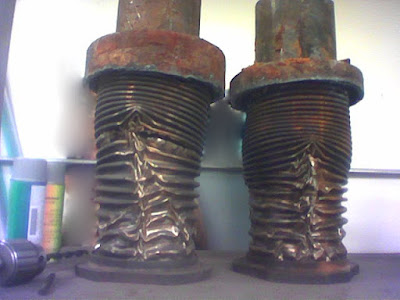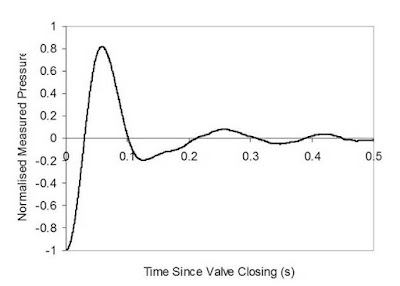Causes of, and Ways to Prevent, Water Hammer in Industrial Piping Systems
 |
| Expansion joints on a steam line destroyed by steam hammer. |
Very strong pressure pulses or surges, also referred to as water hammer (also know as hydraulic shock or fluid hammer), often occur in fluid-conducting pipes. The stresses on the pipes, valves and apparatus can be so high that the equipment concerned is damaged – or in extreme cases actually bursts. Before effective measures can be taken to combat this problem, it is important to analyze exactly which kind of water hammer is involved and what causes it. Yet no matter how carefully a facility is planned and constructed, the risk of pressure surges cannot always be completely ruled out, particularly if the plant is modified or extended or the operating mode changes frequently. If the plant components are designed with sufficient stability, half the battle is won.
Causes of Water Hammer
Water hammer in pipes can have a variety of causes. A basic distinction is drawn between hydraulic water hammer and thermal water hammer.
Hydraulic Water Hammer and Cavitational Hammer
If a globe valve (e.g. a butterfly valve) is closed abruptly while liquid is flowing through a pipe, the fluid flow immediately comes to a standstill and the kinetic energy is converted to pressure energy, in other words a water hammer pulse is produced upstream of the valve. This pulse is propagated at sound velocity from the point of origin against the original flow direction and reflected at points of discontinuity (vessels, pipe ends, etc.). The shock waves generally travel back and forth several times; they gradually lose their intensity due to dissipation be-fore finally fading away.
The pressure increase downstream of a fast-acting valve can be approximated using the classic Joukowski equation.
Δp = ρ ⋅ a ⋅Δv
where:
Δp = Pressure increase [Pa]
ρ = Fluid density [kg/m]
a = Sonic speed [m/s]
Δv = Change in flow velocity [m/s]
The pressure surge reaches its maximum height when:
ts ≤ 2 * l/a
where:
ts = Closing time [s] of the valve
l = Length [m] of the pipe section in which shock waves can be propagated without being reflected.
 |
| Typical pressure wave caused by closing a valve in a pipeline. |
Downstream of the valve, the pressure decreases due to the inertia of the trans-ported liquid. If it drops below the steam pressure, the liquid evaporates locally and a "cavitation bubble" forms.
The subsequent condensation process is usually very abrupt. The magnitude of the pressure peak, which is also referred to as "cavitational hammer", varies according to the valve type and closing speed and can be much higher than the normal system pressure. Once again, the resulting shock waves may be replicated a number of times in the pipe be-fore they come to a standstill due to friction.
Thermal Water Hammer
If hot steam meets large accumulations of condensate because the piping system is insufficiently drained, sudden evaporation (or "flashing") occurs. The resulting changes in volume are a cause of water hammer – in many cases violent – with strong pressure surges that can easily exceed the operating pressure.
Water hammer also occurs in condensate systems if sub-cooled condensate is fed into a condensate pipe that is partially filled with flash steam. A vacuum is created locally as the flash steam condenses. Strong pressure surges are like-wise produced by the subsequent inflow of condensate at high velocity. In other words, there is always a risk of water hammer if condensate with different temperatures collects in a header.
Measures to Prevent Water Hammer
The water hammer described here can usually be prevented by designing the facility optimally; the measures that are suitable for avoiding hydraulic water hammer are totally different from those implemented to counter thermal water hammer.
Since the intensity of hydraulic water hammer depends on the operating times of the globe valves, the starting and stopping times of the pumps and the flow velocity, water hammer pulses can be restricted – if not completely eliminated – by altering these parameters. Unlike water hammer pulses on the inlet side of the valve, the formation of a cavitation bubble can only be prevented by selecting a significantly higher closing time, which will probably be unacceptable in practice. If the parameters are fixed, water hammer can be damped – though not avoided – by installing bladder accumulators or air vessels and leveraging the compressibility of the gas volume in this apparatus.
A good first step towards eliminating thermal water hammer in steam facilities is to ensure adequate drainage. A wise choice of steam trap, in combination with an optimal arrangement of the drain and condensate pipes, is crucial here. The risk of water hammer is particularly great when a cold plant is started up because this is when there is most condensate.
For more information about ways to avoid damages resulting from water hammer, contact Tri-State Technical Sales Corporation by calling (610) 647-5700 or visiting https://tristatetechnicalsales.com.
Reprinted with permission from ARI Armaturen.
Reprinted with permission from ARI Armaturen.